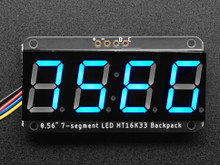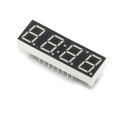 Loading... Please wait...
Loading... Please wait...Categories
- 3D Filament
- Laser Parts
- 3D Printers
- 3D Printer Parts
- Microcontrollers and FPGA
- Shields and daughter boards
- Official Arduino
- Batteries
- Cases and Enclosures
- Cables and Connectors
- CNC
- Components
- Digi XBee
- Displays
- Electronic Brick
- Kits
- Laser Cutters
- LEDs
- Micro:bit
- Motors
- Neodymium Magnets
- Power Supply and Adapter
- Python
- Raspberry Pi
- RFID
- Robotics
- Sensors
- Soldering Equipment
- Tools
- Wearables
- Wireless

Product Description
What's better than a single LED? Lots of LEDs! A fun way to make a small display is to use an 8x8 matrix or a 4-digit 7-segment display. Matrices like these are 'multiplexed' - so to control all the seven-segment LEDs you need 14 pins. That's a lot of pins, and there are driver chips like the MAX7219 that can control a matrix for you but there's a lot of wiring to set up and they take up a ton of space. We feel your pain! After all, wouldn't it be awesome if you could control a matrix without tons of wiring? That's where these adorable LED matrix backpacks come in.
The matrices use a driver chip that does all the heavy lifting for you: They have a built-in clock to multiplex the display. They use constant-current drivers for ultra-bright, consistent color (the images above are photographed at the dimmest setting to avoid overloading our camera!), 1/16 step display dimming, all via a simple I2C interface. The backpacks come with address-selection jumpers so you can connect up to four mini 8x8's or eight 7-segments (or a combination, such as four mini 8x8's and four 7-segments, etc) on a single I2C bus.
The product kit comes with:
- A fully tested and assembled LED backpack with a pre-soldered ultra-bright 4-digit 0.56" tall blue seven-segment display
- 4-pin header
To get you going fast, we have revised this popular board to be the same size and pinout as before but now with two STEMMA QT connectors on either side that are compatible with the SparkFun Qwiic I2C connectors. This allows you to make solderless connections between your development board and the HT16K33 or to chain it with a wide range of other sensors and accessories using a compatible cable.
We also have a detailed tutorial showing you how to solder, wire and control the display. with a very nice library for the backpacks so you can get running in under half an hour, displaying images on the matrix or numbers on the 7-segment. If you've been eyeing matrix displays but hesitated because of the complexity, this is the solution you've been looking for!
Technical Details
This board/chip uses I2C 7-bit address between 0x70-0x77, selectable with jumpers
- Backpack Dimensions: 50.0mm x 26.7mm x 6.0mm / 2.0" x 1.1" x 0.2"
- Backpack Weight: 5.6g
- 7-Segment Display Dimensions: 19mm x 50mm x 14mm / 0.75" x 2" x 0.56"
- 7-Segment Display Weight: 8.4g
Datasheets, schematic, EagleCAD PCB files, and Fritzing available in the product tutorial














